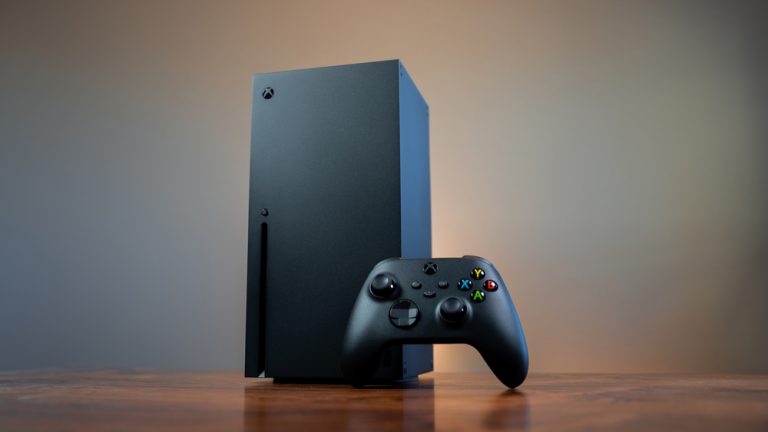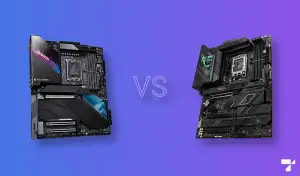The Xbox Series X paved the way for further modernization of the Xbox brand in terms of graphical performance. To this end, the goal was to catch up with PC technology over the last two to three years, with a more significant focus on competitive frame rates played at natively high resolutions.
Given its performance in triple-A PC games since its release, the Xbox Series X GPU equivalent is either the AMD Radeon RX 6700 XT or the Nvidia Geforce RTX 3070. Then again, the Xbox Series X has been known to fall somewhere in between the two GPUs, and there are quite a few design quirks, that could make another GPU more comparable in a different scenario.
What is the Xbox Series X GPU?
The Xbox Series X GPU is an RDNA 2.0-based chip built on TSMC’s 7nm process node, officially referred to as “Scarlett” within its technical documentation. With the target being high-end gaming for the generation of the last two years, it was given a wide headstart in hardware specs. This is all the while reducing the retail cost of the console in order instantly beat equivalent-performing PCs in price efficiency alone.
The main die is 360 mm2 in size, quite bigger than the PS5’s GPU die size. It is powered by 3,328 graphics cores (shading units), supported by 52 compute units. This physical configuration puts it somewhere between the RX 6700 XT and the RX 6800.
In real-world comparisons, though, its performance is more akin to the RX 6700 XT. The Xbox Series X GPU has indeed significantly more shading units, compute units, and wider memory bus width. But, this is somewhat toned down and balanced by its pre-fixed performance modes, lower clock speeds, as well as a slightly reduced texture fill rate, putting it a few steps away from the supposedly nearer RX 6800-level performance.
Xbox Series X GPU Specs
| GPU (code)name | Scarlett |
| Architecture | (AMD) RDNA 2.0 |
| Process node | 7nm (TSMC) |
| Graphics cores | 3,328, 52CU |
| Clock speed (max) | 1,825 Mhz |
| Memory | 10GB GDDR6 |
| Memory clock | 1,750 Mhz |
| Bus width | 320 bit |
| Bandwidth | 560 GB/s |
| TDP | 200 W |
| Texture rate | 379.6 GTexel/s/s |
| FP32 perf | 12.15 TFLOPS |
Design Architecture
RDNA 2.0’s primary improvements over RDNA 1.0 were mainly focused on efficiency. Although it wasn’t near the 50% performance-per-watt improvement as AMD previously claimed, it was enough that it became a primary candidate for the then-upcoming Xbox Series X’s main system. There are proprietary tweaks and modifications, of course, but the following innovations still apply:
- Mesh Shader support
- Samper Feedback support
- Hardware-accelerated ray tracing
- Overall improved heat dissipation and reduced power draw
- Radeon Super Resolution support (future update)
Physical configuration
In more detail, the main chip of the Xbox Series X GPU consists of 3,328 shader units, along with 208 texture mapping units, 64 render output units, and 52 compute units. The GPU hits an upper limit clock speed of 1,825 Mhz, which is incidentally the base clock rate of GPUs using the Navi 21 RDNA 2.0 die such as the RX 6800 XT and the RX 6900 XT.
Memory specification
The Xbox Series X GPU’s memory hardware is unique among other RDNA 2.0 GPUs. First, it is the only one that is using a very wide 320-bit memory bus width (even the RX 6900 XT “only” uses 256-bit). Second, it uses 10GB of GDDR6 VRAM. For reference, only the original, first-release Nvidia Geforce RTX 3080 uses this configuration, but it is on a completely different architecture. The amount is mostly enough for that time’s graphical assets and texture capabilities and will provide considerable headroom for the next few years even in 4K resolution.
Theoretical performance
The numbers shown on these specs might not convert directly to actual gaming benchmarks. But comparatively at least, the Xbox Series X GPU’s texture rate of 379.6 GTexel/s and FP32 performance of 12.15 TFLOPS is most closely compared to the RX 6700 XT, which is rated at 413.0 GTexel/s and 13.21 (FP32) TFLOPS. The Nvidia equivalent, the RTX 3070, has a lower texture rate of 317.4 GTexel/s but has a much higher FP32 performance rating of 20.31 TFLOPS.
Practical performance
When translated to actual games, the Xbox Series X punches well above the intended resolution and frame rates of 1080p/1440p/4K and 60/120FPS. While 120 FPS is only available for some optimized titles, the console can still hit a stable 60 FPS in native 4K for many titles, only switching momentarily to a slightly reduced resolution scale, such as when traversing the open areas of Spider-Man Remastered. Even better, well-designed and highly optimized triple-A games, such as Forza Horizon 5, can be switched to any graphical setting with absolutely no noticeable dip in visual fidelity, while still maintaining target frame rates and near-perfect rendering stability.
If playing at 1080p or 1440p resolution, any HDMI 2.0 compatible high-refresh-rate monitor will do. However, if you want to play (well-optimized) games that can be tuned to 120 FPS at 4K, you strictly need a monitor that supports HDMI 2.1, as well as a cable that can support the necessary bandwidth.
Heat dissipation requirements
With a TDP of 200 watts, the Xbox Series X GPU is directly comparable to any of the higher-end RDNA 2.0 GPUs. This is to be expected, and the chassis of the console is well-designed to effectively dissipate this heat without worrying about thermal issues.
Xbox Series X GPU Equivalent
The actual performance of the Xbox Series X is actually more in-between the RX 6700 XT and RX 6800. But, as a direct equivalent, the RX 6700 XT comes quite closer, both in terms of relative theoretical performance margins, and the overall tier design of the GPU. The major difference is, of course, the rather limited 192-bit memory bus width of the RX 6700 XT. It is also quite noteworthy to point out that the Xbox Series X GPU has an effective max clock speed that is similar to the default gaming clock speed of the RX 6800 (also the base clock speed of the RX 6800 XT and RX 6900 XT).
As for its Nvidia Counterpart, the Geforce RTX 3070, comparative benchmarks shows it to be slightly above the RX 6700 XT, which is even closer to its gap with the RX 6800. Though to be fair, when textures and shadow settings are maxed, the RTX 3070 can potentially fall behind just a tiny bit (and therefore appear somewhat weaker than the Xbox Series X) due to its limiting 8GB GDDR6 VRAM.
Xbox Series X GPU Compared to PC GPUs
For a more quantitative comparison, here is a chart that compares the Xbox Series X GPU to other PC GPUs:
Specifications and theoretical performance:
| Xbox Series X GPU | RX 6700 XT | RX 6800 | RTX 3070 | |
|---|---|---|---|---|
| Architecture | RDNA 2.0 | RDNA 2.0 | RDNA 2.0 | Ampere |
| GPU Cores | 3,328, 52 CU | 2560, 40 CU | 3840, 60 CU | 5888, 46 SM |
| Boost Clock | 1,825 Mhz | 2,581 Mhz | 2,105 Mhz | 1,725 Mhz |
| Memory | 10GB GDDR6 | 12GB GDDR6 | 16GB GDDR6 | 8GB GDDR6 |
| Memory Clock | 1,750 Mhz | 2,000 Mhz | 2,000 Mhz | 1,750 Mhz |
| Bus width | 320-bit | 192-bit | 256-bit | 256-bit |
| Texture rate | 379.6 GTexel/s | 413.0 GTexel/s | 505.2 GTexel/s | 317.4 GTexel/s |
| FP32 perf | 12.15 TFLOPS | 13.21 TFLOPS | 16.17 TFLOPS | 20.31 TFLOPS |
| TDP | 200 W | 230 W | 250 W | 220 W |
(Listed RTX 3070 is for reference only)
As mentioned earlier, VRAM-related settings should be taken into account when comparing the RTX 3070’s relative performance. It can go significantly lower than the Xbox Series X if the VRAM is maxed out on certain games’ Ultra settings.
Actual real-world performance, at 4K (PC versions on Ultra settings):
| Xbox Series X | RX 6700 XT | RX 6800 | RTX 3070 | |
|---|---|---|---|---|
| Doom Eternal | 120 FPS | 128 FPS | 157 FPS | 122 FPS |
| Assassin’s Creed Valhalla | 60 FPS | 43 FPS | 50 FPS | 45 FPS |
| Metro Exodus (Enhanced) | 60 FPS | 43 FPS | 54 FPS | 50 FPS |
| Dirt 5 | 60 FPS | 60 FPS | 60 FPS | 64 FPS |
| Far Cry 5 | 60 FPS | 70 FPS | 87 FPS | 71 FPS |
| Shadow of the Tomb Raider | 60 FPS | 57 FPS | 70 FPS | 62 FPS |
(Benchmark Sources: Hardware Unboxed, Tom’s Hardware)
While most of the superior numbers can be attributed to the Xbox Series X not exactly using the same Ultra settings, the results also partially reflect better software optimization, as well as the use of feature tweaks (like setting-based or dynamic resolution scaling) that might still have to be toggled on/off (DLSS/FSR), or straight up not available on the PC.
CPU performance should not be an issue for this benchmark data, by the way, as it is taken in 4K (almost exclusively GPU-bound).
How Software Impacts GPU Performance
As hinted by the previous benchmarks, there is a distinct performance bias towards the Xbox Series X simply due to how well-optimized the games are designed for the console. Especially with the generous use of just a tiny bit of resolution scaling to keep frame rates in proper check. So even if porting titles is easier with cross-platform X86 compatibility since the Xbox One, there will always be certain tweaks available only on the Xbox Series X’s unique software environment that would always enhance performance levels to relative playability.
Far Cry 6 is perhaps one of the most recent notable games to give as an example. The previous title, Far Cry: New Dawn was already a very impressive game with its balanced PC component performance that allows it to remain as a benchmark title even several years after its release. But, the newer member of the franchise inadvertently becomes a “balanced” benchmarking tool with all its weird quirks, particularly with next-generation consoles, delivering comparably better framerate stability.
Recommended Graphics Cards (Building a PC via an Xbox Series X Equivalent GPU)
AMD Radeon RX 6700 XT – If you are aiming for 60 FPS 1440p or slightly super-resolution scaled 4K settings, then the RX 6700 XT is still probably closer compared to the RX 6800. To emulate the higher refresh rates provided by the Xbox Series X at 4K using dynamic resolution scaling techniques, it is recommended to make use of either FSR or RSR. The target motherboard’s primary PCIe slots should be at least PCIe 3.0.
Nvidia Geforce RTX 3070 – Another good choice if you plan to play with a mix of 1440p and 4K resolutions. While specs are completely incomparable due to having different architectures, theoretical performance does check out with the Xbox Series X GPU’s number-crunching capabilities. Use DLSS to emulate resolution scaling features whenever possible. Also, watch out for certain games that make intensive use of the RTX 3070’s limited VRAM at 4K.
AMD Radeon RX 6800 – If you want to go for an overkill setup that edges out the Xbox Series X slightly, the RX 6800 will be your premium choice. No super-resolution scaling features are required for most games at 1440p, and probably only a bit for 4K to keep things stable. Just crank the settings to Ultra or High, and you’re ready to go.
Nvidia Geforce RTX 2080 Ti – yes, the very GPU that Nvidia marketed the RTX 3070 to win against is, of course, another alternative choice for Team Green. Setup and tweaking would mostly be the same, and the target resolutions are no different. Maybe it is a bit better towards 4K, but since both are RTX cards anyway, you wouldn’t notice a considerable difference. Oh but, unlike the RTX 3070, VRAM is at 11GB, so just fire away at those custom mods.
Final Thoughts
It’s quite surprising how Microsoft went all out with its latest generation console. The fact that uses hardware on par with a flagship GPU just a year before its release was so unbelievable to PC enthusiasts, that many initially dismissed the claims as mere product hyping campaigns. It doesn’t help that the MSRP is also comparatively dirt cheap, making it even more unbelievable on paper.
But, it did deliver mostly on its promise of modern PC-level gaming as it was finally released. It may lose out on the PS5 occasionally in terms of title-by-title optimization, but for the most part, it can crunch way more graphical power if it needs to offset any potential performance issue.
As for how long it would last, it is expected to age even more gracefully than its two predecessors. Yes, even if it has a considerably lower VRAM than the PS5.
FAQ About the Xbox Series X GPU
1. Is RTX 3060 better than Xbox Series X?
No, raw performance-wise the RTX 3060 is not better than the Xbox Series X. While it may have comparable theoretical performance numbers (12.74 FP32 TFLOPS), and 12GB of VRAM, it doesn’t have nearly the same memory bandwidth and does not perform with equal stability in 4K, even with the use of DLSS.
2. Is Xbox Series X better than the 2080 Ti
Yes and no, it would ultimately depend on the game. But, the performance should still be somewhat close enough. The RTX 3070’s (the Xbox Series X’s Nvidia counterpart) primary marketing campaign mainly hinged on its ability to edge out the “Turing flagship” after all.
3. What GPU is equivalent to the Xbox Series S?
Based on the nearest architecture and physical configuration, that would be the Radeon RX 5500 XT 8GB VRAM variant. It has a slightly higher number of graphical cores (1,408 shading units, 22 compute units), and has somewhat close theoretical performance values (5.2 FP32 TFLOPS).



